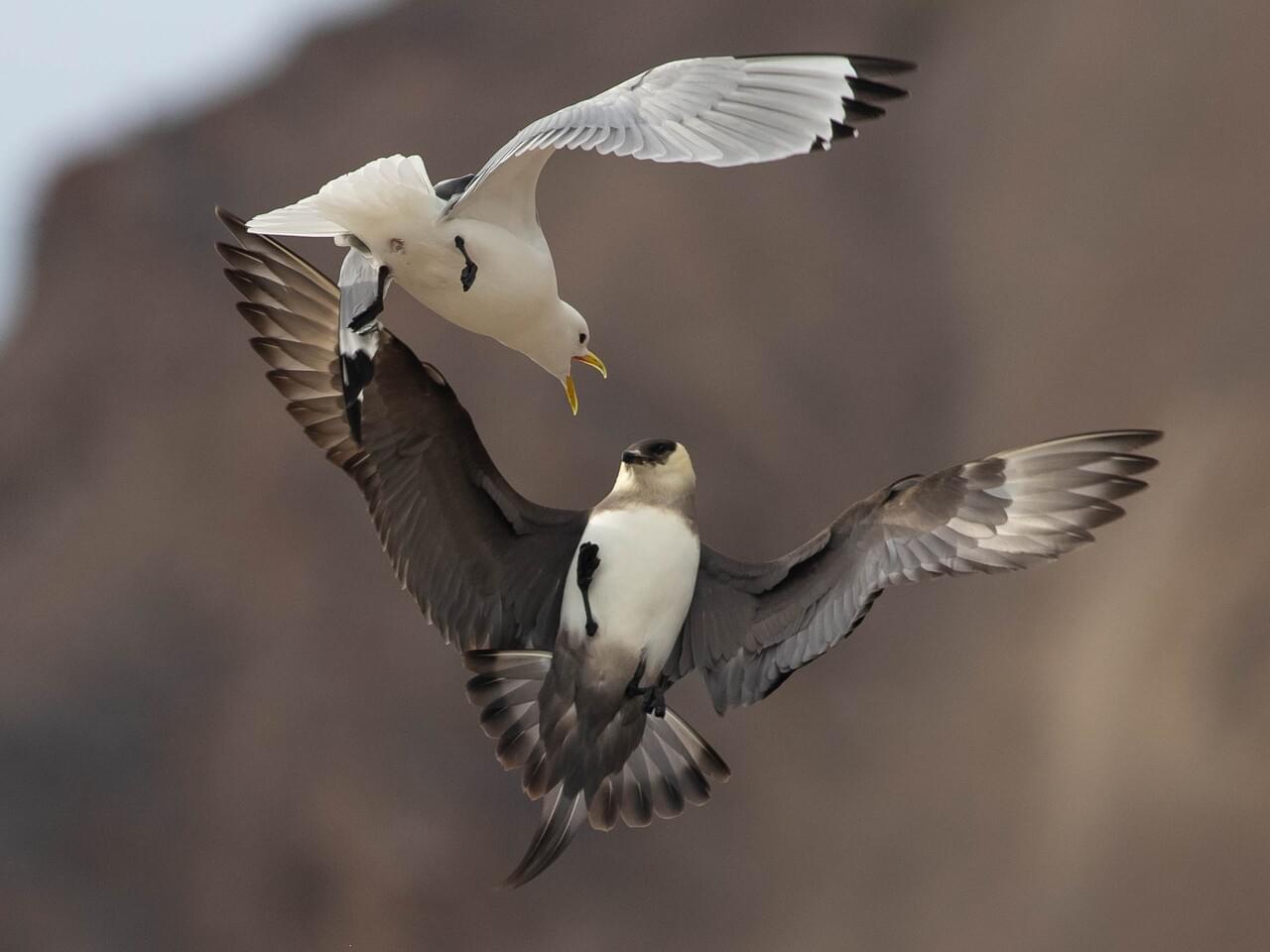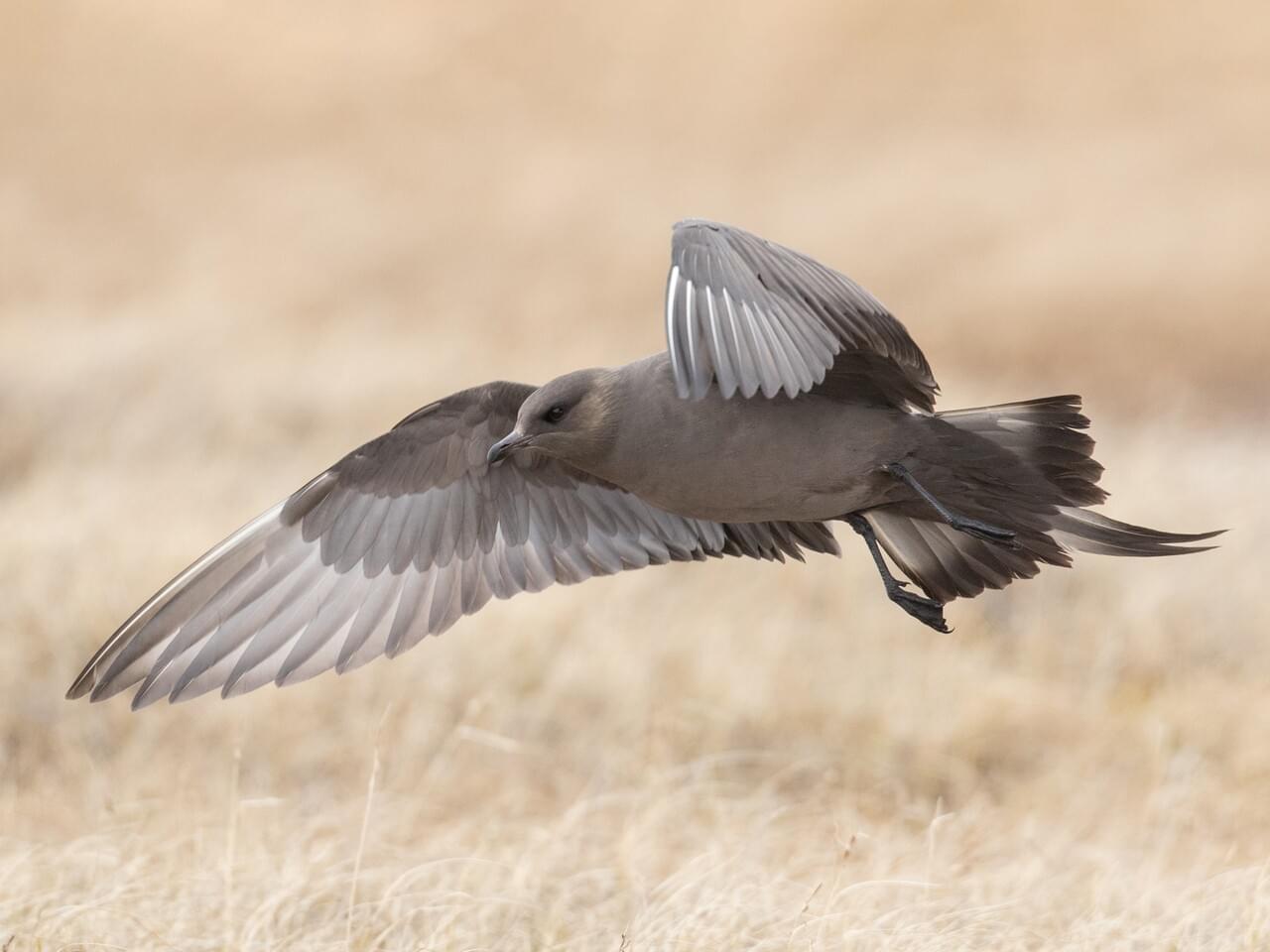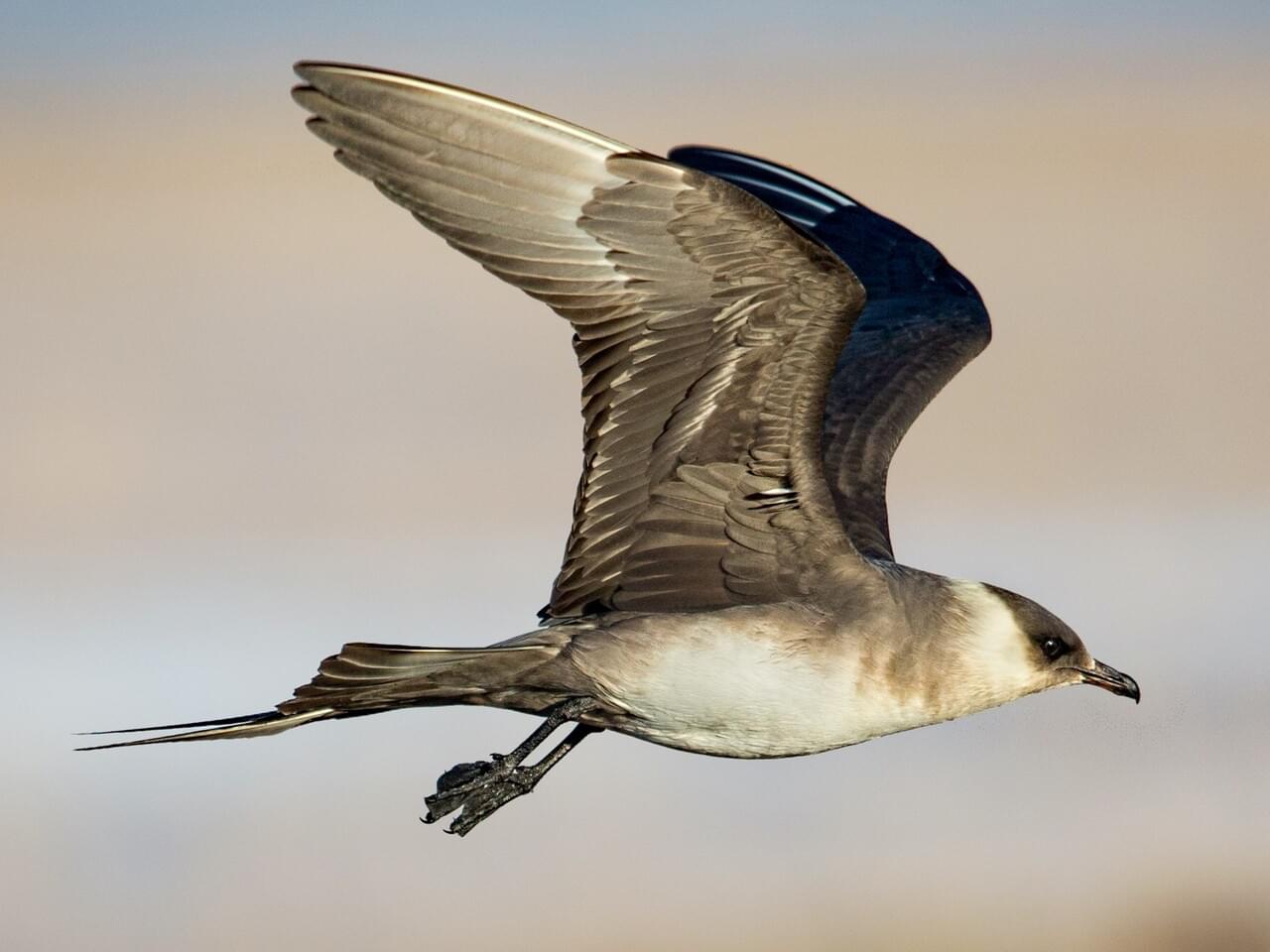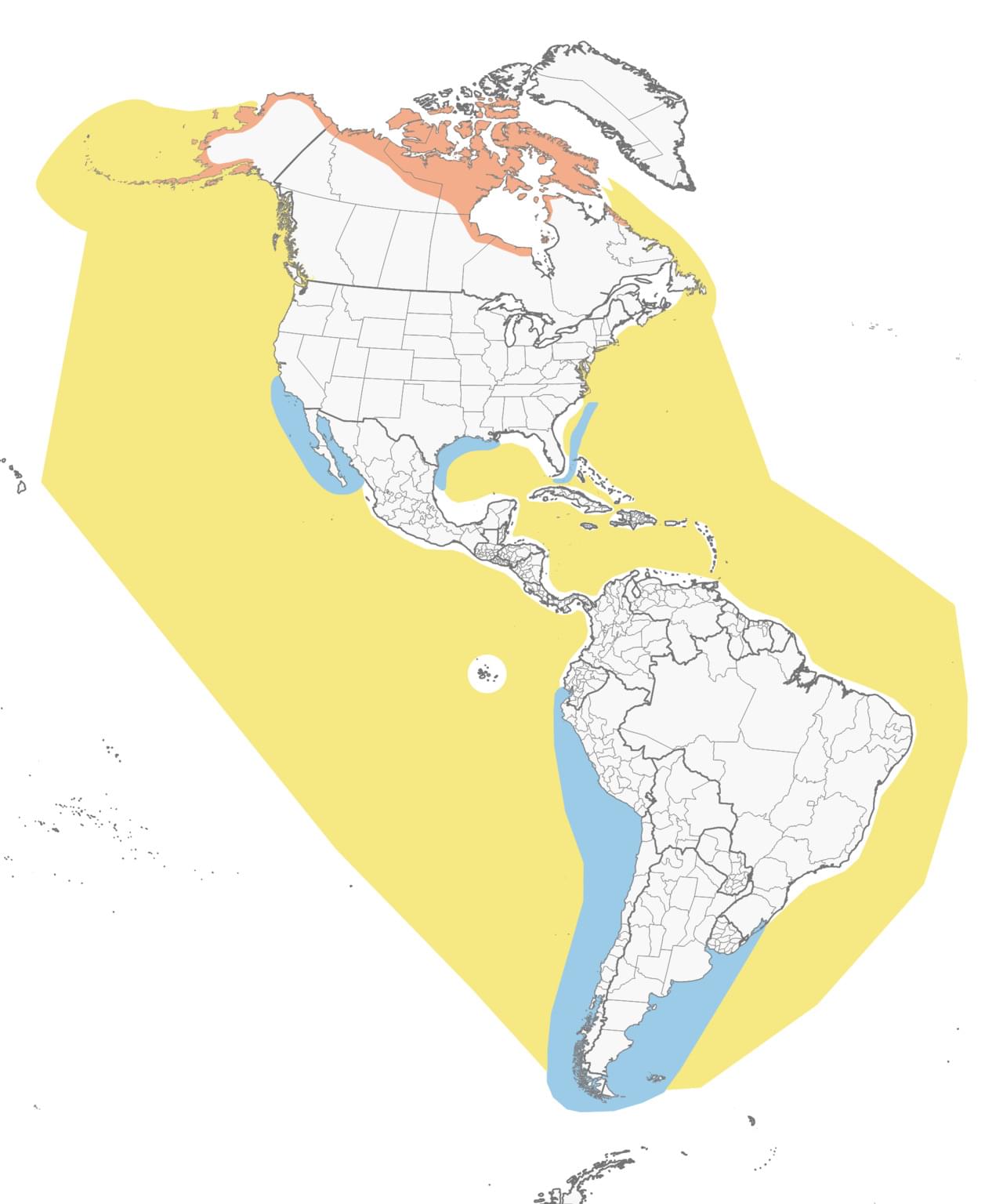As you are scanning the ocean looking for shorebirds you notice something strange through your binoculars. It’s a gull, not an uncommon sight, but its erratic flight patterns are. It’s twisting and turning even flying straight up as high as it can go, it looks as if it is trying to escape something. You look around more and that’s when you see it, a dark flash pursuing the gull, the avian pirate, the bully of the seas, the parasitic jaeger. Enamored by the chase you can’t help but watch. After an exhausting chase the jaeger finally catches its victim and collects its hard-earned meal, straight from the gullet of the gull.

Description & Identification
The parasitic jaeger (Stercorarius parasiticus), also known as the arctic skua in Europe, is a member of the order Charadriiformes (the shorebirds) and the family Stercorariidae (the skuas). It is a relative of the gulls and as such bears a similar appearance. They breed in the arctic tundra and spend the winter in southern and tropical seas. During the breeding season their diet consists of generally whatever they can find, including fish, insects, small mammals, berries, carrion, and other birds (AllAboutBirds). During the rest of the year, their diet becomes far more unique, they get most of their food by stealing it from other seabirds, also known as kleptoparasitism. This is where their name comes from and it can have significant negative effects on the victimized seabirds (Simeone et al., 2014; Jones et al., 2008).
Identification of the parasitic jaeger can be quite difficult. It has three different morphs: a dark morph, a light morph, and an intermediate morph (Janssen et al., 2005) and there are also two other jaeger species in British Columbia, the pomarine jaeger (Stercorarius pomarinus) and the long-tailed jaeger (Stercorarius longicaudus) (AllAboutBirds). Luckily, the parasitic jaeger is the most common to be seen from shore (Sibley, 2016).
Visually the things to look out for when identifying the parasitic jaeger are size, tail length, and wing tips. The parasitic jaeger is the middle size of the three jaegers, with the pomarine being the largest, and the long-tailed being the smallest. They will have a long-pointed tail, but still shorter than the long-tailed jaeger. The last diagnostic feature is the number of white bars on the wing tip. This follows a similar trend to size where the pomarine will have the most, the parasitic will have 4-6 (one on each outermost feather) and the long-tailed will have the least (AllAboutBirds; Sibley, 2016).


As for sounds, they are generally quiet birds, but they do have two common calls. The first is their main call that is a series of nasally two-parted notes that is heard most often during breeding in the arctic. The second is an irregular, sharp, separated note that is often heard during an attack or chase (Audubon; AllAboutBirds).
Behaviour
Parasitic jaegers will generally first start breeding at the age of four or five and tend to nest as isolated pairs or small colonies. Mates are chosen by the female based on a flight display by the male accompanied by calls, upright posturing, and supplying of food. After mating, the male will find a nest location on the ground, often on a slant, and the female will build a nest in a shallow depression using plant material. Jaegers lay one to three olive to brown eggs and incubation takes place for about a month by both parents. During which they are quite territorial and often defend their nests (Audubon).
As the namesake of the species, kleptoparasitism is one of the most notable behaviours of the parasitic jaeger. This is when a jaeger will chase another bird, often a tern or gull, until it regurgitates or spits out its food (Dakota, 2009). The jaeger will first fly low to the ocean camouflaging with its dark plumage. Once in position, the jaeger will try to surprise the victim to make them drop the food. If this does not work, then the jaeger will instead try and chase the bird until it drops its food. Although the jaeger harasses other birds, it rarely results in a physical attack (Taylor, 1979, as cited in Dakota, 2009). This technique is not flawless though, many birds have learned to counter it by foraging in large groups and mobbing any jaegers that pose a threat (Dakota, 2009).
Distribution
Parasitic jaegers are considered long-distance migrants. During the breeding season they can be found in both the North American and European arctic. Once the breeding season is over, they undergo a massive migration to the Pacific coast of South America (Simeone et al., 2014). During migration, they will spend a lot of time far out at sea but can often be found on both the western and eastern coasts of North America (AllAboutBirds).

Conservation Status
Parasitic jaegers currently have a conservation status of low risk. They are commonly seen, have a wide geographic range, and are expected to have a breeding population of 3.5 million (Partners in Flight). While parasitic jaegers are not at risk themselves, they are becoming a conservation risk for many other shorebird species as climate change worsens. Traditionally, jaegers will eat a lot of rodents while breeding in the arctic, but due to bad snow conditions, rodents are becoming more scarce. In response to this, shorebird eggs have become a common replacement in the diet of the jaeger resulting in reduced shorebird populations (Krupp, 2018).
Current Research
Most studies on the parasitic jaeger have focused on either breeding ecology, kleptoparasitism, or systematics (Simeone et al., 2014). But one recent area of research has been the jaegers primary molt duration and timing (van Bemmelen et al., 2018). The primary molt is the replacement of the outermost wing feathers of a bird. As these feathers are integral to flight, it is important for birds to time the molt, as to not overlap with high-intensity flight (Hedenström, 2006).
A study by van Bemmelen et al., 2018 set out to determine what characteristics affect the primary molt of all the jaegers, as well as the great skua (Stercorarius skua), a larger species. Using photographs from the internet, photographers, and authors to see molt patterns they tried to answer four main questions. 1) Does larger size result in a longer molt time; subsequently, 2) does this result in increased overlap between molting and migration; 3) do species that winter further south have a shorter molt duration; and 4) does molt duration decrease with age (van Bemmelen et al., 2018).
The authors found that size does have an affect on molt duration and timing. The largest of the Stercorariidae, the great skua had the longest duration molt (147 days), while the smallest, the long-tailed jaeger had the shortest (82 days). The great skua also had more overlap between their molt and migration period, possibly due to size. Interestingly, although the parasitic and pomarine jaeger differ significantly in weight, they did not differ greatly in molt duration (122 and 118 days respectively). The authors suspect this is because the parasitic jaegers require higher quality feathers due to their chasing tendencies, resulting in a higher molt duration (van Bemmelen et al., 2018).
For migration distance the results were not as clear. The great skua, which has the shortest migration distance, did have the longest molt duration. But the pattern broke down when it came to the jaegers, where the molt duration did not differ significantly whether they were above or below the equator (van Bemmelen et al., 2018). The results for the age tests were also inconclusive, where no clear patterns were seen for molt duration with respect to age (van Bemmelen et al., 2018).
References
All About Birds. Accessed Oct. 7, 2022. https://www.allaboutbirds.org
Audubon. Accessed Oct. 7, 2022. https://www.audubon.org
van Bemmelen, R. S. A., Clarke, R. H., Pyle, P., Camphuysen, K. C. J. (2018). Timing and duration of primary molt in Northern Hemisphere skuas and jaegers. The Auk, 135(4), 1043-1054. https://doi.org/10.1642/AUK-17-232.1.
Dakota, A. 2009. Stercorarius parasiticus. Animal Diversity Web. Accessed Oct. 7, 2022. https://animaldiversity.org/accounts/Stercorarius_parasiticus/
Hedenström, A. (2006). Scaling of migration and the annual cycle of birds. Ardea, 94(3), 399–408.
Janssen, K., Erikstad, K. E., Bensch, S. (2005). Offspring sex ratio allocation in the parasitic jaeger: selection for pale females and melanic males? Behavioural Ecology, 17(2), 236-245. https://doi.org/10.1093/beheco/arj015.
Jones, T., Smith, C., Williams, E., Ramsay, A. (2008). Breeding performance and diet of great skuas Stercorarius skua and parasitic jaegers (arctic skuas) S. parasiticus on the west coast of Scotland. Bird Study, 55(3), 257-266. https://doi.org/10.1080/00063650809461531.
Krupp, L. (2018, November 13). The Arctic Is No Longer A Safe Haven for Breeding Shorebirds. Audubon. Accessed Oct. 7, 2022. https://www.audubon.org/news/the-arctic-no-longer-safe-haven-breeding-shorebirds
Partners in Flight. Accessed Oct. 7, 2022. https://partnersinflight.org
Sibley, D. A. (2016). Sibley Birds West: Field guide to birds of western North America (Second ed.). New York: Alfred A. Knopf.
Simeone, A., Anguita, C., Luna-Jorquera, G. (2014). At-sea abundance and distribution of skuas and jaegers (Charadriiformes: Stercorariidae) at coastal waters off central Chile. Revista Chilena de Historia Natural, 87(1). https://doi.org/10.1186/0717-6317-87-6.
Taylor, I. R. (1978). The kleptoparasitic behaviour of the arctic skua Stercorarius parasiticus with three species of tern. Ibis (London, England), 121(3), 274-282. https://doi.org/10.1111/j.1474-919X.1979.tb06844.x.
Interesting, I had no idea that kleptoparasitism existed
No fowl play here! Just a delightful read!
Very interesting. Maybe the jaeger can be a new Batman villain ( the Jäegermeister?)
Great read. It would be interesting to read more about the negative impact they have on other birds, especially if they are going after eggs now.
Hey Krystyn, great blog. Kleptoparasitism is such an interesting concept. Do you know if Jaegars select nesting sites around other birds such as gulls so that they have reliable victims to steal from?
Hi Sean, thanks for the question! Generally the kleptoparasitism tends to be more common during the migratory period of the birds where it makes up most of their feeding. While breeding they tend to either hunt more traditionally or forage, so who their neighbours are is less important at this stage.
Hey, I also like birds, what is your favourite bird
Hi Birdguy1982, given the blog, I am quite fond of the parasitic jaeger. But, prior to this blog other birds I liked were the barn swallow and the crested ibis. The former because I like how it looks, the latter because it’s recovery from a very small population is quite inspirational and makes for a good story!
Great read. I will email this around the office. Random bird info for you, researchers such as yourself found a recently thought to be extinct species: the black-naped pheasant-pigeon (Otidiphaps insularis). Documented for the first time in 140 years. 🙂
Do they catch rodents with their talons? They don’t look as long as Raptor talons.